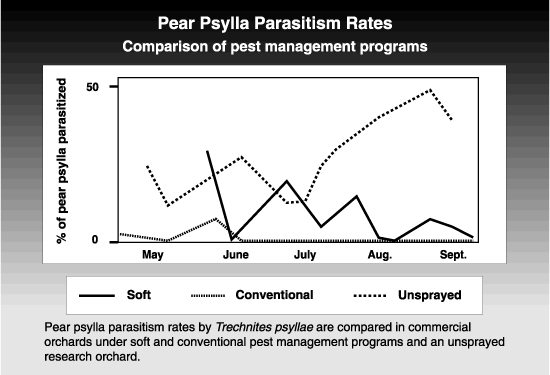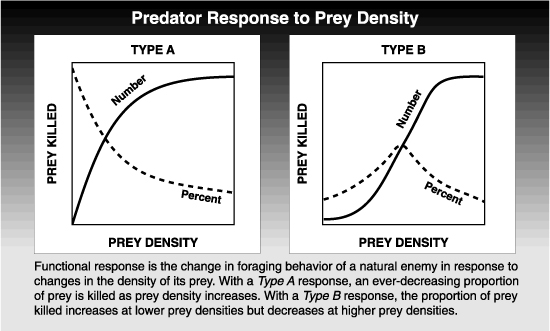by Tom R. Unruh, originally published 1993
Biological control is a means of keeping pests below damaging levels through the activities of predators and parasitoids. Successful biological control can occur with native natural enemies or may be due to the introduction of predators or parasitoids from foreign countries or different regions of the same country.
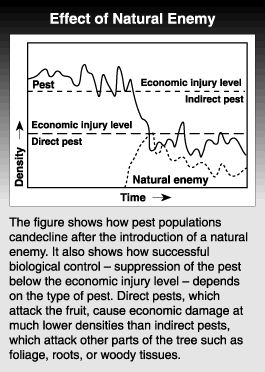 There are three major types of augmented biological control: classical, inoculative and inundative. These are distinguished by the input needed to create a balance between the pest and natural enemy populations.
There are three major types of augmented biological control: classical, inoculative and inundative. These are distinguished by the input needed to create a balance between the pest and natural enemy populations.
Classical biological control involves introducing natural enemies from a pest’s native range into a new area where native natural enemies do not provide control.
Inoculative biological control means releasing natural enemies periodically or seasonally to reestablish a balance that has not been maintained naturally or has been disrupted by other control methods.
Inundative biological control involves the massive production and release of natural enemies to control the pest quickly.
Pest populations may drop after a natural enemy is introduced. Unfortunately, biological control is seldom a predictive science. Biological control introductions are, in effect, grand ecological experiments.
For example, winter moth, a pest of oak, apple and several other deciduous trees, colonized Nova Scotia and British Columbia, Canada, where it became a pest. Dramatically successful control followed the introduction of two of the moth’s natural enemies, a parasitic fly, Cyzenis albicans, and a parasitic wasp, Agrypon flaveolatum. However, in England, part of the moth’s native range, two decades of ecological studies indicated that those parasites did not control the moth. This discrepancy underscores the difficulty of measuring what factors are important in providing natural biological control.
The great benefit of natural enemies is often demonstrated in experiments by using cages or screens to keep pests in, while excluding their natural enemies. Under these conditions, pest populations grow rapidly, often exceeding the damage thresholds for the plant.
Induced pests
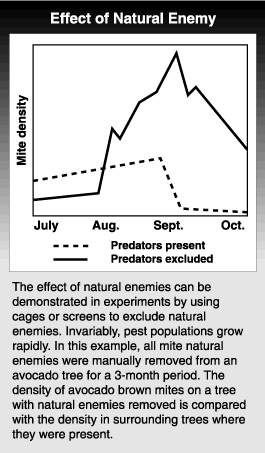 The value of biological control often becomes evident when natural enemies are disrupted by insecticides or other factors, such as road dust or weather extremes.
The value of biological control often becomes evident when natural enemies are disrupted by insecticides or other factors, such as road dust or weather extremes.
An example of how insecticides can disrupt biological control is the explosion of mealybug populations in California pear orchards in the early 1960s following treatments with DDT. The DDT destroyed lacewings that normally kept mealybug populations in check. The problem was solved by periodically inoculating orchards with lacewing eggs, as the immature stages of lacewings could tolerate DDT.
Insects that become pests because their natural enemies are killed by insecticides are referred to as insecticide induced pests. Several secondary pests of tree fruits are induced pests. Pest mites are induced by use of pyrethroids, which kill their natural enemies. Western tentiform leafminer and white apple leafhopper are induced to pest status by broad-spectrum insecticides. Crop damage by pests such as San Jose scale and woolly apple aphid may be induced partly by overzealous and mistimed insecticide use. Pear psylla is also an induced pest because broad-spectrum insecticides commonly used to control codling moth kill its natural enemies.
Specialization
Specialization, the close association of pest and natural enemy, is a key to success in many cases. The woolly apple aphid is controlled in many countries and is the only host of the parasitoid Aphelinus mali. Sometimes there are specialized races of a natural enemy, which differ in their preference for a particular host or prey. For example, strains of Trioxys pallidus that were imported for walnut aphid did not control the filbert aphid in Oregon when they were released there. However, a race of Trioxys pallidus that attacks filbert aphid was discovered and introduced, which provided excellent biological control.
What makes a good natural enemy?
A good biological control agent:
- Is adapted to the pest, and preferably specializes on it
- Does not interfere with other natural enemies
- Is able to reproduce rapidly
- Is suited to the climate and in synchrony with its host or prey
- Can find its host or prey at relatively low densities
Interference
Because a number of different natural enemies can attack a pest, it is possible that one might interfere with another, resulting in worse control than if just one natural enemy had been present. Such cases are rare, however, and often two or more natural enemy species work in concert to control a pest.
Climatic matching
The natural enemy must be suited to the climate in its new home. Otherwise, cold winters or hot summers may make it ineffective at controlling the pest. Another aspect of climatic matching is synchrony between the population cycles of predator and prey or parasitoid and host. For example, synchrony is critical in the interaction between pear psylla and one of its natural enemies, the parasitic wasp Trechnites psyllae. The wasp lays its eggs in the second through fifth nymphal stages of pear psylla. The parasitoid larva develops inside the nymph for about 2 weeks before killing it. Many pear psylla migrate out of the orchard to overwinter and return in early spring to lay eggs. Trechnites, however, remains in the orchard. Parasitoid larvae that develop in psylla nymphs in the fall induce their hosts to crawl off the leaves into bark where mummies are formed. Thus, Trechnites overwinters in the orchard in diapause within the host mummy. The timing of pear psylla egg laying, hatch, and population growth in the spring varies considerably from year to year. To control pear psylla, emergence of Trechnites must coincide with the presence of young nymphs. Studies in unsprayed pear orchards suggest that Trechnites can kill a significant proportion of the spring brood of pear psylla when insecticides are absent. However, in some locations or some years Trechnites is not well synchronized with the development of pear psylla and control is poor. A parasite with better synchrony with pear psylla under Pacific Northwest conditions would be valuable.
Finding the prey
A natural enemy’s ability to find and use its prey or host can dramatically affect the success of biological control. How the predator responds to different prey densities is called its functional response. The critical question is whether the pattern and rate of prey consumption lead to control.
If a predator is to control the prey, a greater proportion of the prey must be killed as prey densities increase. This maintains a stable interaction between predator and prey populations.
There are two types of predator response to increases in prey density. With a type A response, the number of prey killed increases at a slower rate at higher prey densities. This means that as prey density increases, the percentage killed decreases. This type of response does not lead to stable predator-prey interactions.
With a type B response, there is an increasing percentage of prey killed as density rises…up to a point. Then, as densities rise further, the increase in the prey consumption slows down and so a lower percentage is killed. This type of response can lead to a stable predator-prey interaction under some circumstances.
Changes in the behavior of the predator can lead to a type B response. Prey switching is one example. A predator may feed on one prey species until another’s density increases to the point where it is more profitable for the predator to switch and feed on it instead. Such switches are common among generalist predators.
A searching behavior that increases the likelihood of a predator finding prey at high densities can also result in a type B response. Picture a pest unevenly distributed in patches on leaves of a tree. A predator arrives on a leaf and begins to search. If it fails to find prey after a certain time, it leaves, but if the predator finds a prey, it tends to stay and search the leaf more thoroughly. So, when many prey are on the leaf the predator is more likely to encounter one, which encourages it to look for more. As a result, the number of prey found increases disproportionately as the predator starts actively looking. However, prey densities may eventually reach the point where they are increasing faster than the predator can consume them, and the proportion killed will begin to drop.
Biological control opportunities
Biological control has an expanding role in fruit pest management in the Northwest. Although fruit growers have accepted and used integrated mite management tactics for more than a generation, there is increasing emphasis on the biological control aspect of IPM for other pests.
There are many opportunities to improve biological control of fruit pests. Decisions to spray for a pest must be weighed carefully against the potential effects on predators and parasites. These decisions require better knowledge of the natural enemy complex and relative abundance of natural enemies. These strategies are already available for mites and the tentiform leafminer (see Indirect Pests).
Codling moth is the key to most of the pest management decisions in pear and apple. As a direct pest, one which damages the fruit, it has a low economic injury level. Codling moth probably originated in Soviet Central Asia and, with only one of its old-world parasites established in the Pacific Northwest, natural enemies have little impact. For the last 60 years or more, it has been controlled with insecticides, to the detriment of biological control of other pests.
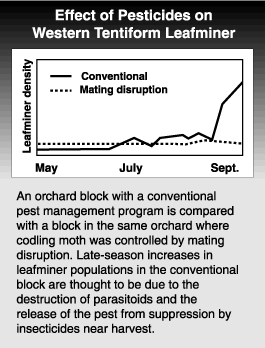 New approaches to codling moth control include mating disruption (see section on Mating Disruption) and releases of sterile moths. Pests, such as the white apple leafhopper and western tentiform leafminer, should diminish in orchards where mating disruption replaces broad-spectrum insecticides. In addition, soft insecticide programs, such as those based on insect growth regulators, are being developed and should provide other selective, nondisruptive tools to control pests such as leafrollers and other pests that occur as sporadic outbreaks.
New approaches to codling moth control include mating disruption (see section on Mating Disruption) and releases of sterile moths. Pests, such as the white apple leafhopper and western tentiform leafminer, should diminish in orchards where mating disruption replaces broad-spectrum insecticides. In addition, soft insecticide programs, such as those based on insect growth regulators, are being developed and should provide other selective, nondisruptive tools to control pests such as leafrollers and other pests that occur as sporadic outbreaks.
Left uncontrolled, codling moth will damage almost the entire crop. If nothing else, introducing and establishing codling moth’s natural enemies in trees outside the orchard, such as in crab apple and backyard trees, could halve the numbers of codling moth migrating into orchards from those sources.
There has been limited foreign exploration for exotic enemies of pear psylla, which also originated in Eurasia. Studies published in the Soviet Union suggest that parasitoids related to the Trechnites species that is found in the Pacific Northwest give good control of pear psylla in eastern Europe and central Asia. It is difficult to find pear psylla there, even in commercial orchards where the climate is similar to that in the Northwest. It is important to find out if natural enemies are regulating pear psylla in those regions and, if so, what biological control agents should be imported. Similarly, additional natural enemies for San Jose scale, woolly apple aphid and leafrollers should be sought and imported as new biological control agents.
New pests
One of the greatest concerns for fruit growers is the invasion of the Pacific Northwest by new pests. Apple maggot and plum curculio, both endemic in the eastern United States, present real threats to the pome fruit industry. Although soft management programs have been developed for apple maggot, they are expensive and labor intensive. No soft insecticides or alternatives are available to control plum curculio. In the eastern United States one or two applications of broad-spectrum insecticides are used for control.
Washington was recently colonized by two exotic pests of apple, apple ermine moth and winter moth. It should be possible to control winter moth by importing and establishing the parasites that now control it in Canada.
An outbreak of apple ermine moth was detected on suburban trees in the Bellingham area in 1985. It has since spread south to the Columbia River west of the Cascade mountain range. Populations near Bellingham have stabilized or declined because of the activities of generalist predators, such as birds and spiders. An important parasite of apple ermine moth from Eurasia has been established in the area to help improve biological control.
Apple ermine moth is not a threat to orchards where broad-spectrum insecticides are used regularly but could be a persistent pest in orchards where codling moth is controlled with mating disruption or sterile males.
